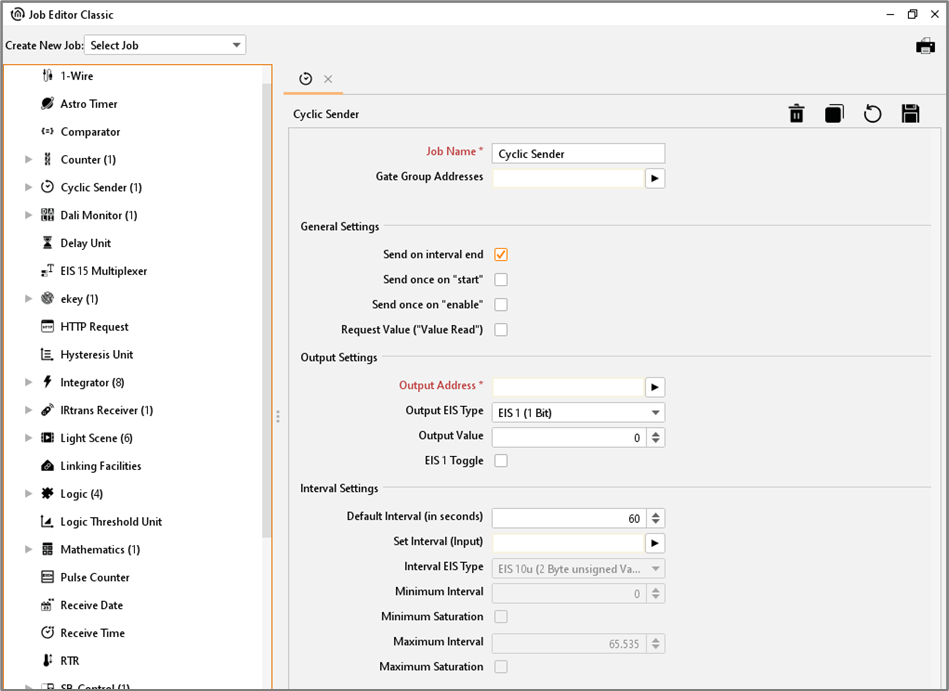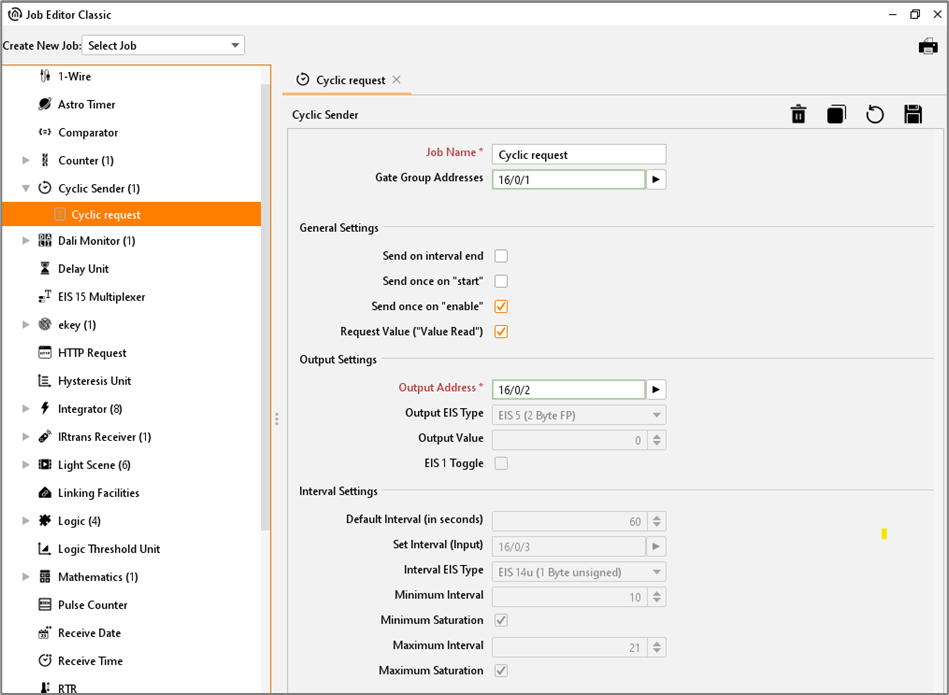Cyclic Sender
The cyclic sender sends out KNX telegrams in a fixed and dynamic interval, offers the possibility to retrieve the state of particular group addresses and will send on device start optional.

Job Editor Classic - Job Configuration Cyclic Sender
Job Name
Required field. Assign a unique name for the job. The name must not contain more than 15 characters.
Gate Group Addresses
By Gate Group Addresses job will be released or blocked. The release object releases or locks the job. It is about an EIS1 object:
Field blank = Job is released.
Field completed, value 1 = Job released.
Field completed, value 0 = job locked.
Field completed, no value = job locked.
As soon as one address is filled in, release will behave respective to the value of the group address. If no value was sent to the address and the address is presently without values, job will be blocked.
General settings
Send on interval end
If this option is enabled, job will send (the first time) only then if interval time is over. In case the option is not enabled, transmission takes place directly after storing the job, resp. after releasing or starting the device.
Send once on “start”
By the help of this option, job sends out a telegram uniquely either after restarting of the job (erasing or storing of a job) or after booting the device. A cyclic transmission doesn’t take place. If option “Send on interval end” (see above) is enabled, job will send only after once the device is rebooted and the interval time is over.
Request value (“Value Read”)
By using the option „Request Value (“Value Read”), cyclic sender will transmit a so called „Read telegram“ or “value read” – telegram. With the help of these telegrams, state information of certain group addresses can be requested. To make this possible, desired device resp. group addresses have to be configured correspondingly in the ETS-software (“read-flag enabled”)
Please note: Handle this function carefully! The response on this value read telegrams will be treated as normal switching telegrams.
Output Settings
Output address
Mandatory field. On this group address the value, which is determined by following parameters, has been transmitted. Without a valid address, saving the job is not possible.
Output EIS-Type
Please define the EIS type of the “output address”. Following data types are available:
EIS 1 (1 Bit), value [0,1]
EIS 5 (2 Byte FP), floating point value [-671088,64 … 670760,06]
EIS 6 (1Byte), value [0…100%]
EIS 9 (4 Byte FP), floating point value [- 2-127 … 2128]
EIS 10u (2Byte), value unsigned [0 … 65535]
EIS 11u (4 Byte), value unsigned [0 … 4.294.967.295]
EIS 14u (1Byte), value unsigned [0 … 255]
Output Value
Depending on the data type chosen in the upper mentioned option you will define the output value here.
EIS 1 Toggle
This option is only available if “EIS 1 (1 Bit)” is chosen as “Output EIS-Type” in the array above. In this case, the value of group address will change cyclically between “1” and “0”. It will start with the value determined in “Output value”.
Interval Settings
Default Interval (in seconds)
Please define the interval time here (time between two sent telegrams) in seconds. Minimal value is “1”, maximal value is “65535”. A new stored interval time will be valid not until the next interval start. Running interval will be finished with the time was adjusted before.
Set Interval (Input)
This input object is enabling setting an interval time by group address. Setting interval time by group address takes place under the same circumstances as manual regulation of interval time in the job mask (see above, minimal/maximal value, start of the new interval), independent of the data type. The datatype “Interval EIS Type” of this object has been set in the array below.
Interval EIS Type
This entry array will only be enabled if a valid group address was entered above in „Set Interval (Input)”.
The following data types are available:
EIS 10u (2 Byte), value unsigned [0 … 65535]
EIS 11u, (4 Byte), value unsigned [0 … 4.294.967.295]
EIS 14u (1 Byte), value unsigned [0 … 255]
Because the interval time in seconds is limited to 65.535 at maximum, no higher interval value could be placed, also if data type EIS 11u (4 Byte) is used.
Please note: With following parameter, the interval time set by a desired group address, can be forced within limits.
Minimum interval
This input field will only be enabled, if in “Set Interval (Input)” a valid group address is entered. The numerical value used here describes the lower limit for setting the interval time by group address. If a value is sent lower this limit, job will use either the predefined interval time of the job mask, or, if the the option “Minimum Saturation” is set, the minimal limit of time adjusted here. The value can be adjusted in the range of 1 to 65535.
Specific feature: If “minimal interval” is set to „0“, and this value will also be sent on the object “Set Interval (Input)”, job will use the predefined interval time of the job mask (“Default Interval (in seconds)”).
Minimum Saturation
This input field will only be enabled, if in “Set Interval (Input)” a valid group address is entered. By enabling this option, the interval time set in “Minimum Interval” will be used as interval time in case the group address value of “Set Interval (Input)” is lower than the minimum interval set.
Maximum interval
This input field will only be enabled, if in “Set Interval (Input)” a valid group address is entered. The numerical value used here describes the upper limit for setting the interval time by group address. If a value is sent higher this limit, job will use either the predefined interval time of the job mask, or, if the option “Maximum Saturation” is set, the maximal limit of time adjusted here. The value can be adjusted in the range of 1 to 65535.
Maximum Saturation
This input field will only be enabled, if in “Set Interval (Input)” a valid group address is entered. By enabling this option, the interval time set in “Maximum Interval” will be used as interval time in case the group address value of “Set Interval (Input)” is higher than the maximum interval set.
Application example:
Request the value of a certain group address after “enable”.
An application example for the cyclic sender is to request the value (“value read”) of a certain group address, due to a trigger event. Please proceed as follows:
Apply the new job “Cyclic Sender” and parameterize following settings:
“Job name” = Assign a unique name to the job.
“Gate Group Addresses” = Allocate the group address by which the process should be started here.
“Send once on “enable”” = Enable this option, so that the job will send once after enabling by gate group address.
“Request Value (“Value Read”)” = Enable this option, so that the job will send a value read telegram.
“Output address” = Please fill in the group address of the KNX-subscriber here, which state should be requested. Please consider that the “Read flag” must be set.
Save the job.

Cycle Sender - Sample configuration
If now value “1” has been sent on the gate group address object (enable job), the job will send a value read telegram on the “output address” once. In case KNX-subscriber was configured correctly (Read flag set, see above), it will send out its actual value to the same group address as reply. To repeat this process, it will be enough to send value “1” to the gate group address object again.
